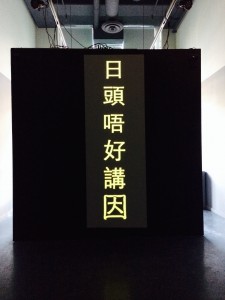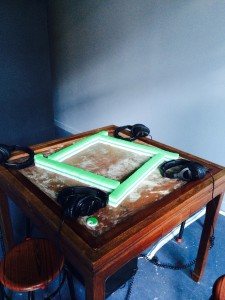Language and Politics in Chinatown: (transgression/cantosphere) Gallery Review
The (transgression/cantosphere) exhibition at Vancouver Chinatown’s gallery Centre A (Vancouver International Centre for Contemporary Asian Art) features an installation by interdisciplinary art company Hong Kong Exile (HKX). Hong Kong Exile consists of artists Natalie Tin Yin Gan, Milton Lim, and Remy Sui, all of who collaborated with linguist Zoe Lam and Vancouver-based artist Howie Tsui to produce conceptual visual and audio works that focus on relevant issues affecting Chinatown.
In one piece, the Chinese characters for transgression and cantosphere are projected over a street sign with the words “Historic Chinatown”. The Chinese characters flickering over boldly printed English words imply the struggle and need to have a displaced voice recognized and heard over a more dominant Western voice. For a separate work, unpunctuated English vinyl texts wraps across the gallery walls, making the text difficult to decipher. Another piece in the exhibition features alternating Cantonese idioms flashing on a vertical projection screen in a darkened room. Idioms such as “Welcome to Chinatown” and “Change is later than disobedience” are then manipulated. Specific words in each phrase are swapped with a tonal alternative of the same syllable to alter the idiom’s original meaning. While the projection is running, audio of shuffling mahjongg tiles plays in the background to characterize the rearranging of these phrases. Mahjongg is also featured in a separate installation where viewers can sit at a table and listen to headphones that loop recordings of Tsui being taught how to pronounce Cantonese words.
It is clear that the exhibit is the artists’ way of responding to the issue of Mandarinization—an issue relating to the Chinese government’s political regulations to establish Manadarin as the national standard language. This problem is becoming more and more relevant to Vancouver’s Chinatown, where Cantonese-speaking communities in Chinatown are being affected by the more dominating Western and Mandarin languages.
Today, Chinatown’s cultural heritage is being infringed upon by Vancouver urbanites that are not fluent in Cantonese. The projected idioms and headset audio in the exhibition speak to this increasing concern, as all the works in the gallery convey the growing unfamiliarity with Cantonese language due to the steady removal of the Cantonese dialect in Chinatown’s cultural spaces. For instance, the hostile rearranging of the projected idioms suggests the erasure of the Cantonese language, while the looped audio recordings represent an individual’s attempt to learn and preserve a language that is slowly being expunged by political forces.
(transgression/cantosphere)’s querying of language relates to the concept of language structures that has been raised in class, which includes how language is translated and interpreted. The audiovisual and visual components of the exhibition are instruments that express how language can be communicated and received, since some viewers will be able to read and understand Chinese characters while others will not. Hence, the exhibition’s artists transform the gallery space into an important linguistic space where the artist can interrogate Chinese language and simultaneously invite gallery visitors to reflect on the effects different forms of language have on cultural heritage.
Language is transmitted across different mediums to create an experience that is both confrontational and powerful, both accessible and inaccessible. The experience ultimately encourages us to think about how language is socially produced, preserved, and threatened.


